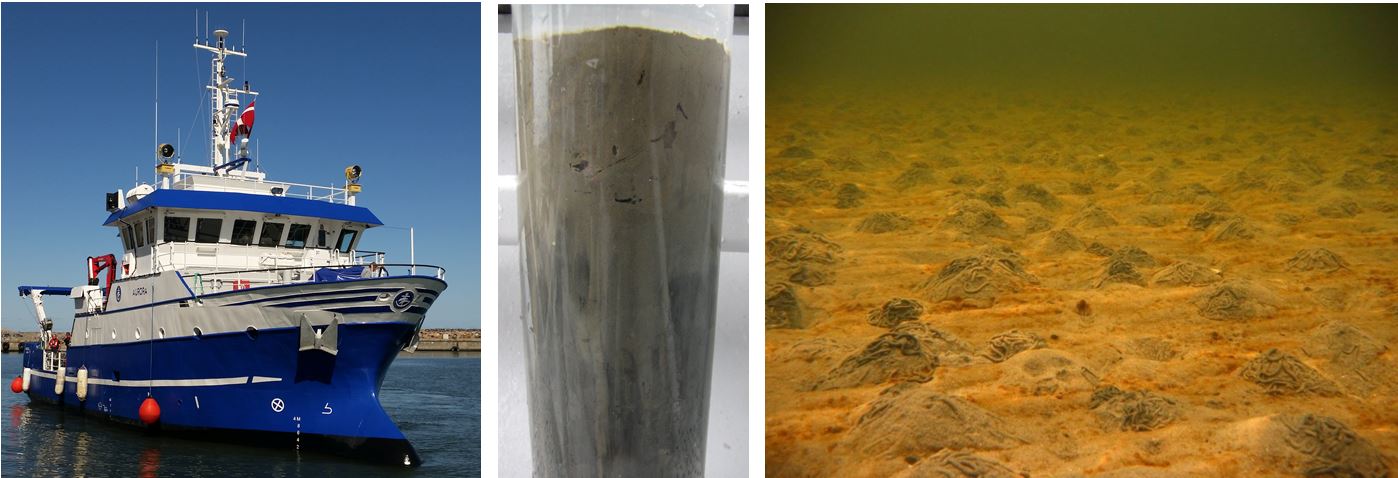Researchers from ETH Zurich show that the activity of bioturbating animals, such as worms, clams, and shrimps, are the most important driver of the community structure of microorganisms in continental shelf sediments.

Sediments underlying the world's oceans and shelf seas cover >70% of the Earth's surface area. These sediments are the biggest reservoir of organic carbon in the biosphere, hosting over one thousand times more organic carbon than the atmosphere, soils, and seawater combined. Most of this organic carbon was originally produced by organisms, such as phyto- and zooplankton, plants, and animals, that inhabit overlying water and nearby land and whose remains after death were deposited to sediments by sinking through the water column.
The marine carbon cycle, burrowing animals, and microbial activity
The burial of vast quantities of organic carbon in marine sediments is a driving force behind Earth's climate and free oxygen concentrations. Yet, the factors that control whether this carbon remains buried over geologic time scales or returns to the hydro- and atmosphere on shorter time scales are not well understood. Microorganisms play an important role by breaking down organic carbon to the greenhouse gases carbon dioxide and methane. Today, only ~7% of incoming sedimentary organic carbon evades microbial degradation and becomes part of the long-term carbon sink. Carbon cycling by microorganisms is in part controlled by animals. These animals alter surface sediments by burrowing and by introducing seawater via a process called bioturbation.
In spite of their importance in the carbon cycle, there are many unanswered questions regarding the ecology of marine sedimentary microorganisms. One of the most basic ones is: what controls the distribution of microbial species? The answer to this question would provide important insights into the sedimentary carbon cycle, since different sediment microorganisms vary in their carbon-cycling metabolisms and their ability to use or tolerate exposure to oxygen.
What controls the communities of sediment microorganisms?
Deng et al., in a study published in Proceedings of the National Academy of Sciences, USA, this week, show that the activity of bioturbating animals, such as worms, clams, and shrimps, is the most important driver of the community structure of microorganisms in continental shelf sediments. The authors compare 5-meter-long sediment cores from four locations of the Skagerrak-Kattegat region at the North Sea-Baltic Sea transition and show that surface sediments with burrowing fauna have highly similar communities of microorganisms, even if they differ greatly in sedimentary characteristics. By contrast, microbial communities of deeper sediment layers that are not reached by burrowing animals are clearly distinct from those in surface sediments of the same sites, and are instead more similar to surface sediments of a site where animals are absent.
Sediment chemical analyses reveal that sediment animals control microbial communities by two fundamental processes, i.e. the pumping of oxygen-rich seawater into otherwise oxygen-free sediment and the introduction of fresh organic matter from the sediment surface into deeper layers by feeding activities. Remarkably, these two processes differ in their impact on the two main divisions of microorganism that are present in sediments, the Bacteria and the Archaea. While bacterial communities are largely controlled by the faunal input of energy-rich, fresh organic matter, Archaea are mainly driven by the effect of macrofauna on O2 input. Within the Bacteria and Archaea, the distributions of individual groups also show clear habitat preferences related to organic carbon sources and sediment oxidation state. As a result, Deng et al. produce the first systematic framework that predicts the distribution of different groups of Bacteria and Archaea in marine sediments.
Importance and further implications of this work
Deng et al. produce the first holistic framework that explains the distribution of microbial species in marine surface sediments, and suggests that the two dominant groups of sediment microorganisms, Bacteria and Archaea, are not only evolutionarily distinct, but also occupy distinct ecological niches. Despite numerous previous investigations on bioturbating fauna and microbial communities in marine sediments, the direct link between macrofaunal activities and microbial identities had not been previously demonstrated. The study is thus a major advance toward understanding what controls the community structure of microorganisms in marine sediments and toward using this understanding to predict and map organic carbon cycling in the seafloor. Such knowledge on the distributions of microbial carbon-cycling reactions is essential to understanding the factors that control the fate of sedimentary organic carbon and therefore also the size of the long-term sedimentary organic reservoir.
This study, furthermore, offers a prime example of how the integration of knowledge from different fields, in this case geology, geochemistry, macroecology, and microbiology, can produce important new scientific insights. By merging knowledge and techniques from these fields, the researcher team from Switzerland, Denmark, the United States, and Taiwan transcends traditional disciplinary boundaries, and creates new understanding of a complex natural ecosystem that is controlled by the interplay of many environmental variables.
References
- Deng L, Bölsterli D, Kristensen E, Meile C, Su C-C, Bernasconi SM, et al. Macrofaunal control of microbial community structure in continental margin sediments. Proceedings of the National Academy of Sciences. 2020:201917494. doi:10.1073/pnas.1917494117
- Personal profiles of Longhui Deng and Mark Lever






